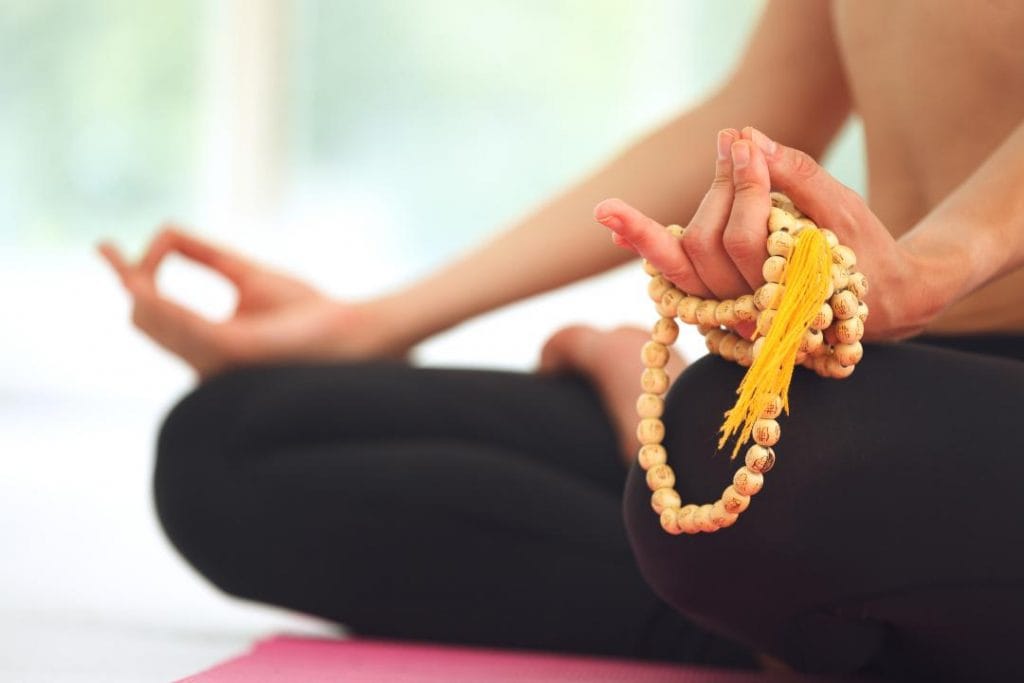You’ve seen them in yoga class or seen them worn as spiritual jewelry, but do you really know the history behind the mala bead? Malas are used in meditation to create peace and calm. Read this guide for more information on Buddhist prayer beads, or malas, how to use them, and their history.

Have you noticed more people wearing beads lately?
They might be Buddhist prayer beads – also known as malas.
And they’re not new. In fact, malas have been around for thousands of years. Their earliest origins stem from India and Nepal.
Malas have long been used in traditional prayer and meditation. But more and more Westerners are discovering them for their calming energy – both in meditation and in everyday life.
And you don’t have to be Buddhist to use them.
Buddhist Prayer Beads (Malas) Are for Everyone
Repeating certain mantras – either mentally or out loud – is a huge part of many meditation practices. And it’s not unusual for a mantra to be repeated thousands or even hundreds of thousands of times for long-time meditators.
This is where the mala comes into play.
So What IS a Mala?
A mala is rather like a spiritual abacus.
From the Sanskrit word for Buddhist prayer beads, the mala is used for counting off the above-mentioned mantra recitations during meditation. They’re still used today in the same way.
The most common type of mala is a string of 108 round beads. The beads are usually between 7 – 10mm in size and their round shape allows them to glide easily through your fingers.
During a meditation, you hold the mala and work your way around it, saying a mantra for each bead while rolling it between your fingers. Finishing the circuit means you’ve completed 100 recitations.
The other 8 beads are extras to make up for any mistakes you might make along the way.
There is also a head bead that is larger than the others. This bead is known as the guru bead.
While some believe that the guru bead has special significance, it does have a practical purpose. It’s the starting and finishing point for the circuit and is not included in the 108-count.
Sometimes, a mala may have precious stones like quartz or turquoise added at various intervals. These are there to assist with your counting. For example, if there’s a precious stone after every 27 beads, then you’ll know when you’re 25%, 50%, and 75% through the meditation.
In this case, there will be 111 beads rather than 108.
There is also a smaller, wrist-sized mala made of 27 beads. This “bracelet” mala is wrapped around your hand and traveled around 4 times.
Yet even if the meditator is not actively counting, the repeated recitation of the mantra while moving bead through bead on the mala helps to focus and calm the mind.
The History of Mala Beads
Sometime around the 8th century BCE, ancient seers in India began using beads to assist with their meditation.
The Mokugenji Sutra tells the story of a king named Haruri who was in sorrow over the distressed state of the people in his small country. He asked the Buddha to help him to understand.
According to the Sutra, the Buddha replied:
“King, if you want to eliminate earthly desires and to put an end to their suffering, make a circular string of 108 beads made from the seeds of the Mokugenji tree. Hold it always to yourself. Recite ‘Namu Buddha – Namu Dharma – Namu Sangha.’ Count one bead with each recitation.”
Namu comes from the Sanskrit for devotion/dedication. And it is in this text we find the origin of meditation beads.
Although 108 is the standard number of beads in both Hinduism and Buddhism, the reason given for that number is different for each.
Hinduism recognizes 108 as an austere number based on its cosmic significance.
Buddhism takes a more concrete approach. The 108 actually refers to the number of human passions to which one is striving to put an end.
The 108 Human Passions
According to Buddhists, each of the 108 beads represents a human passion that impedes enlightenment. They are as follows:
Abuse – Aggression – Ambition – Anger – Arrogance – Baseness – Being a Know-It-All – Belittlement – Blasphemy – Calculation – Callousness – Capriciousness – Censoriousness – Conceit – Contempt – Cruelty – Cursing – Deceit – Deception – Delusion – Derision – Desire for Fame – Deviousness – Dipsomania – Discontent -Discord – Disrespectfulness – Dissatisfaction – Dogmatism – Effrontery – Egoism – Envy – Enviousness – Excessiveness – Faithlessness – Falseness – Gambling – Garrulity – Gluttony – Greed – Greed for Money – Grudge – Hard-hearted – Hatred – Haughtiness – Headiness – High-Handedness – Hostility – Humiliation – Hypocrisy – Ignorance – Imposture – Imperiousness – Impudence – Inattentiveness – Indifference – Ingratitude – Insatiability – Insidiousness – Intolerance – Intransigence – Irresponsibility – Jealousy – Lack of Comprehension – Lechery – Lust for Domination – Lust for Power – Malignancy – Manipulation – Masochism – Mendacity – Mercilessness – Negativity – Obsession – Obstinacy – Oppression – Ostentatious -Pessimism – Prejudice – Presumption – Pretense – Pride – Prodigality – Quarrelsomeness – Rage – Rapacity – Ridicule – Sadism -Sarcasm – Seduction – Self-Denial – Self-Hatred – Sexual Addiction – Shamelessness – Stinginess – Stubbornness – Torment – Tyranny – Unfriendliness – Unyielding – Vanity – Vindictiveness – Violence – Violent Temper – Voluptuousness – Wrath
The Buddhists believe that meditating on each of these human passions ultimately creates positive spiritual energy known as japa. That’s why you’ll often hear malas referred to as japa malas.
What Are Malas Made Of?
Historically, malas were made from the rudraksha seed because it was believed to hold spiritual and healing power. Malas from bodhi seeds were also revered since they represented the ancient fig tree under which Buddha attained enlightenment.
Today, traditional japa malas are still made from seeds like rudraksha, as well as other seeds, sacred woods, nuts and even carved bone.
Mala beads made from carved bone signify impermanence and the necessity for compassion during our time living in this world. Those made from wood, nuts or seeds represent a spiritual connection with the earth.
But malas are also made with a wide variety of gemstones with specific healing properties. For example, the lapis lazuli stone helps calm the mind, while rose quartz promotes compassion and the amethyst gemstone is believed to enhance clarity of thought.
Malas can also be made of shell, metal, or any other materials that can be inscribed or painted with symbols, words or mantras.
And because they’re made with natural materials, no two malas will ever be exactly the same. Each one is a symbolic and highly personal addition to your meditation practice.
To bring new energy to your meditation, find out more about getting your own custom japa mala.
How to Meditate with a Mala
There’s really no wrong way to meditate. And you don’t need to have any prior knowledge. You could do it while at the office on your lunch hour, or on a family camping trip.
You simply need a quiet place to sit for some amount of time where you will not be bothered or interrupted. If you’re brand new to meditation, this amount of time could be as little as a minute or two – until you’re comfortable with 10-15 minutes.
Start with the mala in your left hand. Gently hold the bead next to the guru bead between your index finger and thumb. Take a few deep breaths until you feel relaxed. Then you’re ready to begin.
Continue to breathe deeply and slowly, moving the beads one by one through your fingertips. Keep this process as smooth and seamless as possible. This slow, steady and repetitive motion sends information to the muscles and the brain to relax the central nervous system.
Each time you hold a new bead, repeat your chosen mantra.
Again, you don’t need to have a special Buddhist mantra. It might be a short statement like, “I am light”, to something as simple as “Om,” or even a word like “peace.”
Your mantra can be spoken, whispered or hummed. It doesn’t matter. Each repetition will generate forward momentum and strengthen your mental focus.
If you’re distracted by a thought, don’t worry. Just return to the bead where you lost your concentration and start over. Remember, you’re not trying to race through your meditation. It’s a slow and continual process.
Just keep the beads moving. When you come upon the guru bead again, you’ll know you completed the entire circuit.
To come out of your meditation, sit quietly for some amount of time. Take a few deep breaths, then stand up and return to your normal activities.
If your meditation is not an immediate “success,” keep at it. It’s probably not going to relax you immediately like a hot bath. It takes time and practice for the mind to be able to effectively slow down and focus.
Eventually, your mala meditation will start to feel habitual.
How to Care for Your Mala
Your mala is special.
Whether it’s rudraksha or sandalwood, metal or gemstones, it will have significance to you. Especially the longer you use it in your meditation.
To maintain the positive energy of your mala, treat it with respect. Keep it off the floor. Don’t throw it and avoid putting any objects on top of it.
When not using your mala, you may wrap it around your wrist or hang it around your necks. It should be noted though that malas are not meant to be worn as jewelry. And wearing them as a way to show your “spirituality” is also discouraged.
For times when your mala is not on your body, it’s a good idea to hang it up in a place far away from the floor where it might be knocked down or become a play toy for a pet or a child.
Many long-time meditators have altars in front of which they meditate. This is also a good place for your mala.
Ultimately, what you choose to do with your mala is up to you. These are simply guidelines.
Find Peace and Tranquility through Meditation
As we said before, becoming a regular meditator takes time and practice. But with the help of soothing Buddhist prayer beads, you’ll find it easier to focus and calm the mind.
And soon enough, you’ll be meditating every day.
Don’t forget to keep checking back with our health and well-being blog for more inspiration on how to live a happier, healthier life!

I appreciate this information, I had only 1 question. I was told that it is held in left hand, but not to use the index finger and thumb but the middle finger and thumb because the index finger means fire and it should not touch Mala. Is there a big difference?